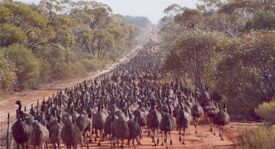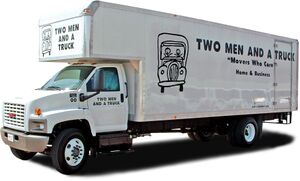Emu War
“We shall go on to the end, we shall fight in Western Australia, we shall fight on the Great Barrier Reef and oceans, we shall fight with growing confidence and growing strength on Aires Rock, we shall defend our island, whatever the cost may be, we shall fight in the desert, we shall fight on the emu nesting grounds, we shall fight in the fields and in the streets, we shall fight in the hills; we shall never surrender, and even if, which I do not for a moment believe, this island or a large part of it were subjugated and starving to the evil emu cause, then our Empire beyond the seas, armed and guarded by the Australian Fleet, would carry on the struggle, until, in God's good time, all the bloody emus will die.”
The Emu War, also known as the Great Emu War, was a war fought between the country of Australia and a flock of emus. It is still remembered in Australia today as the greatest defeat ever incurred on the Australian nation and her subjects. It was fought from 2–8 November 1932 between 20,000 emus, under the command of the Lord High Emu, and two soldiers of the 7th Heavy Battery, Royal Australian Artillery under the command of Major G.P.W. Meredith. Each soldier was equipped with a Lewis Machine Gun, 10,000 rounds of ammunition, and both had received an award in clay pigeon shooting.
Reasoning Behind the War
Emus were seen as a pest in Western Australia, as they were able to duck whenever a boomerang was thrown at them, and therefore the Australian emu hunters could never catch them. The Royal Australian Cavalry had demanded emu feathers to place in their hats so that they could look pretty when charging into battle. Therefore there was high demand for killing these emus, and the whole of Western Australia had been put on red emu alert. This meant that the Prime Minister of Australia enforced martial law and cut off any trade or connections outside Australia. This was so that no support could reach the emu invaders in what became known as the Emu Crisis of '32.
The Battle of Campion
The Australians were very sure that they could give a crushing blow to the emus here, so they set up their Lewis machine guns hoping for some emus to appear. When the emus came, they came in their hundreds. The machine gunners started blasting away. The emus, however, had other ideas, and simply ran at 50 kph away from the machine gun fire. The machine gun rounds that did hit the emus did not seem to hinder them until the emu had been hit about ten times. After a hard day's work sitting at machine gun posts and blast firing away at birds the Aussie soldiers had expended 1000 rounds and killed 12 emus. Things weren't looking good as they had wasted a tenth of their ammunition on killing three five-thousandths of their enemy's troops.
On the next day the troops headed further south — because as their Australian logic told them, the further south they went, the more upside down they became — meaning that when the emus tried to duck oncoming bullets, they couldn't, as they were standing upside down and gravity would pull their heads away from the ground. This strategical genius was put to the test in the Battle of Meredith, named after the major himself. After the first blast of the Lewis guns was fired, the emus worked out the range of these guns and simply moved out of that range. As the machine guns were very heavy, fixed to the ground and couldn't be fired while running along, the Australian troops couldn't hit the emus when they were out of range. Therefore a stalemate ensued for the rest of the day. Meredith also realised that the sneaky birds had surrounded him and his soldiers, cutting the three of them off from the outside world.
A Change in Tactics
Meredith needed to use his brain to compete to the standards of military strategy the Emu bird brains had set. He had to make the most cunning military tactics ever devised by the human race. He wasn't facing any old Napoleon or Alexander, he was facing an army of emus — but he was still determined to win, whatever the cost.
Meredith reformed the whole of the Western Australian army and invented the motorised battalion. He did this by buying an old truck off a farmer for two quid and strapping the machine guns, one on either side, to it. This way the guns could fire whilst the truck was moving. This was a huge step forward for modern warfare and would have been improved on if the following failures hadn't occurred.
The Battle of The Eighth of November
Meredith's new tactic was put into action. A squad of emus was spotted drinking out of a local reservoir. He sent the new motorised battalion, comprised of himself, a truck, two soldiers and a farmer truck driver, hurtling at the enemy. As soon as they were in range, the Lewis guns opened fire. Bullets sprayed everywhere and the Lewis guns had no aim as the truck's suspension was a bit off. Two emus were killed in this run and about thirty in the next run. Emus could also easily outrun the truck, as the its maximum speed was about 24 kph. The emus soon learnt that the truck was no threat and preceded to run into it at full speed, which did more damage to the truck than to the emu. Meredith assessed the situation and realised the only way forward was not to use the reverse gear. The truck drove away from the emus as fast as it could (which was not very fast) and the battle was officially over.
The War Ends
For some reason, the Australian government was teased about committing itself into an official war with a species of bird. It therefore decided to withdraw all military support and spending from the Emu War and declared the conflict officially over. However, this was never agreed with the emus, who still believe the war is in progress even today. The Australian Government have put a ban on any human activity in a eighty kilometre radius of Emuland in Western Australia. Anyone who meets an Aussie emu is advised not to run, as the emu will catch you but to simply coerce it further south for the fore-mentioned reasons. The figures at the end of the war summed up to 9,600 rounds of ammunition used and 960 emus killed. Two farmers got lost on the Aussie side and their bodies have never been found. The emus of Emuland celebrate National Emu Day every year on the 8th of November, usually by inviting the Aussie rugby team over for a match. The emus have gone unbeaten in the rugby match since the event first begun.
Foreign aid and reaction
The Emu War had a giant effect on contemporary society. Winston Churchill was the first politician to understand all its possible consequences and, thus, its importance. He made an impressive call, trying to convince the British people that everyone should participate in the great war. However, his call went largely unanswered. Great Britain had major external problems at that time, which other politicians did not want to bring out into the open (the most significant being a struggle for gaining power within Europe, the USA and the USSR). As a consequence they invented an excuse for not taking this seriously. They convinced people that emus were very rare and different Australian "operations" (how many at the time referred to the "Great Emu War") could harm the ecosystem of the continent.
Politicians of different countries used the same technique and the only country which actually tried to help was France. The President decided to send several boxes of ammunition to Australia (in case it didn't have enough) but the French cargo ship workers were on strike so none of those boxes reached Australia. What Churchill had feared so much was a reality: the Great Emu Empire had won.
See also
| Featured version: 21 June 2013 | |
| This article has been featured on the main page. — You can vote for or nominate your favourite articles at Uncyclopedia:VFH. | |



